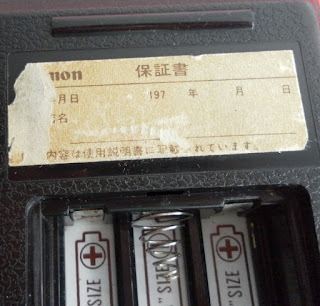Canon Palmtronic F-6 scientific calculator from 1975
This machine uses a green Vacuum Fluorescent Display with 12 x 7-segment digits.Two digits are reserved for minus signals and memory in use annunciation.
Another two digits are used for exponent.
This leaves 8 digits for mantissa.
After power on, the calculator shows a "0.^00".
2^5 (a^x) produces a good enough result: 31.999974^00
The usual forensic check gives this result: 12.199423^00
(Degrees mode. 9 sin cos tan tan^1 cos^1 sin^1)
Trying 1000 ln followed by e^x result in: 999.99964^00
And the classic 1 / 3 followed by * 3 gives a result of: 0.9999999^00
A honest result from this 1975 calculator.
Pi internal constant stored value of: 3.1415926^00
Clearing the calculator and doing e^x twice results in: 2.7182804^00
A singl screw holds the back cover. Solid case build.
Injection molded keys.
Shielding spring connector detail.
It connects the metal front plate to the machine PCB ground.
The Hitachi HD3699 SoC processor is complemented by a DC-DC power supply converter to generate the required high voltage to illuminate the VFD.
The PCA set includes:
- The Processor/Power Supply/VFD main PCB, which in turn holds the Power Supply PCB.
- The Keyboard PCB.
All the three PCB's are soldered to each other by using single core wiring.
I measured the current consumption using a 4.5V power supply.
After power: 60mA
All digits on: 82mA
Calculating sin: 65mA.
This translates to a power consumption of a minimum of 270mW and a maximum of 370mW, much less than the declared 0.6W value in the back cover label (my calculator misses this label).
The VFD terminals are clearly identified.
Terminals "1" to "12" for the digits selection, then "a" to "g" and "dp" for the 7-segments plus decimal point selectors.
The electrolytic capacitors have a working voltage of 50V. I didn't care to check them s the machine works flawlessly with a bright steady VFD light emission..
From the two power supply transistors one one is identified, as D467 (2SD467 NPN Si).
The TDK transformer has a code of CD-1015, Japan.
The date codes in the transitor and in the SoC processor is "5L", so the year 1975 looks to be credible (I don't recall now the Japanese letters for month coding).
Visible in the picture is one broken black plastic pin that I couldn't find its original place.
this machine was opened before by others, bit apparently nothing was modified or repaired as all components terminal solder joints looks untouched.
The 12 digit VFD is soldered to the Processor PCB.




















Sem comentários:
Enviar um comentário